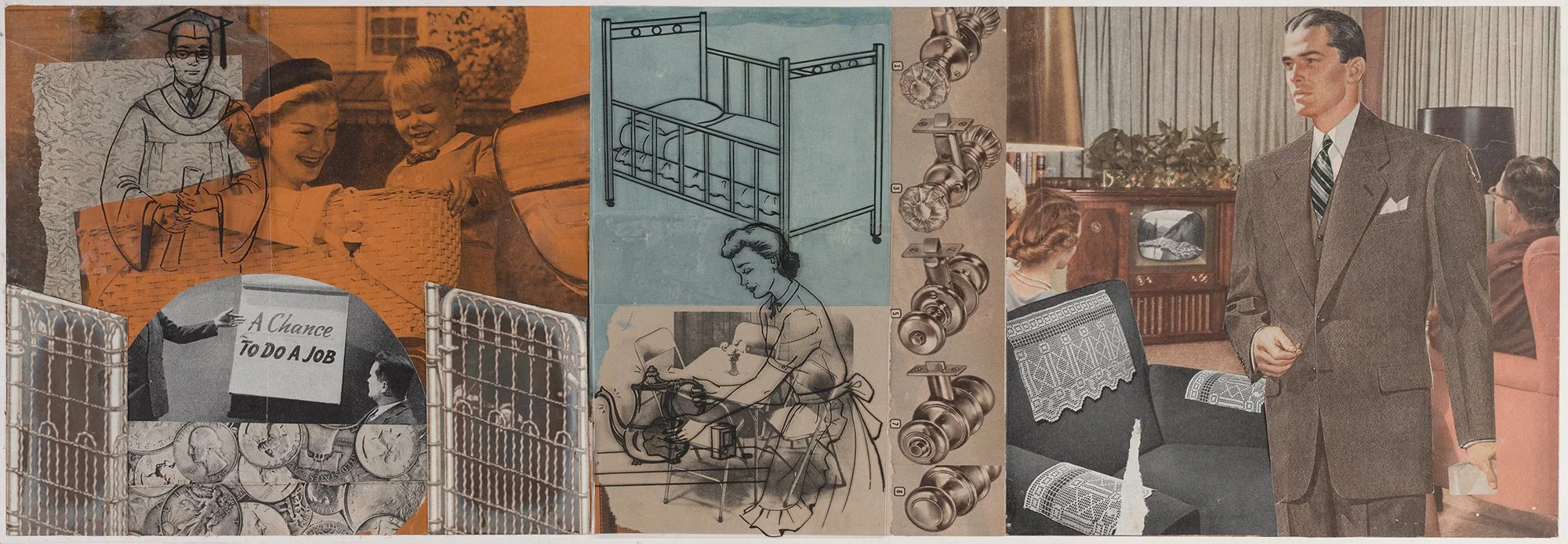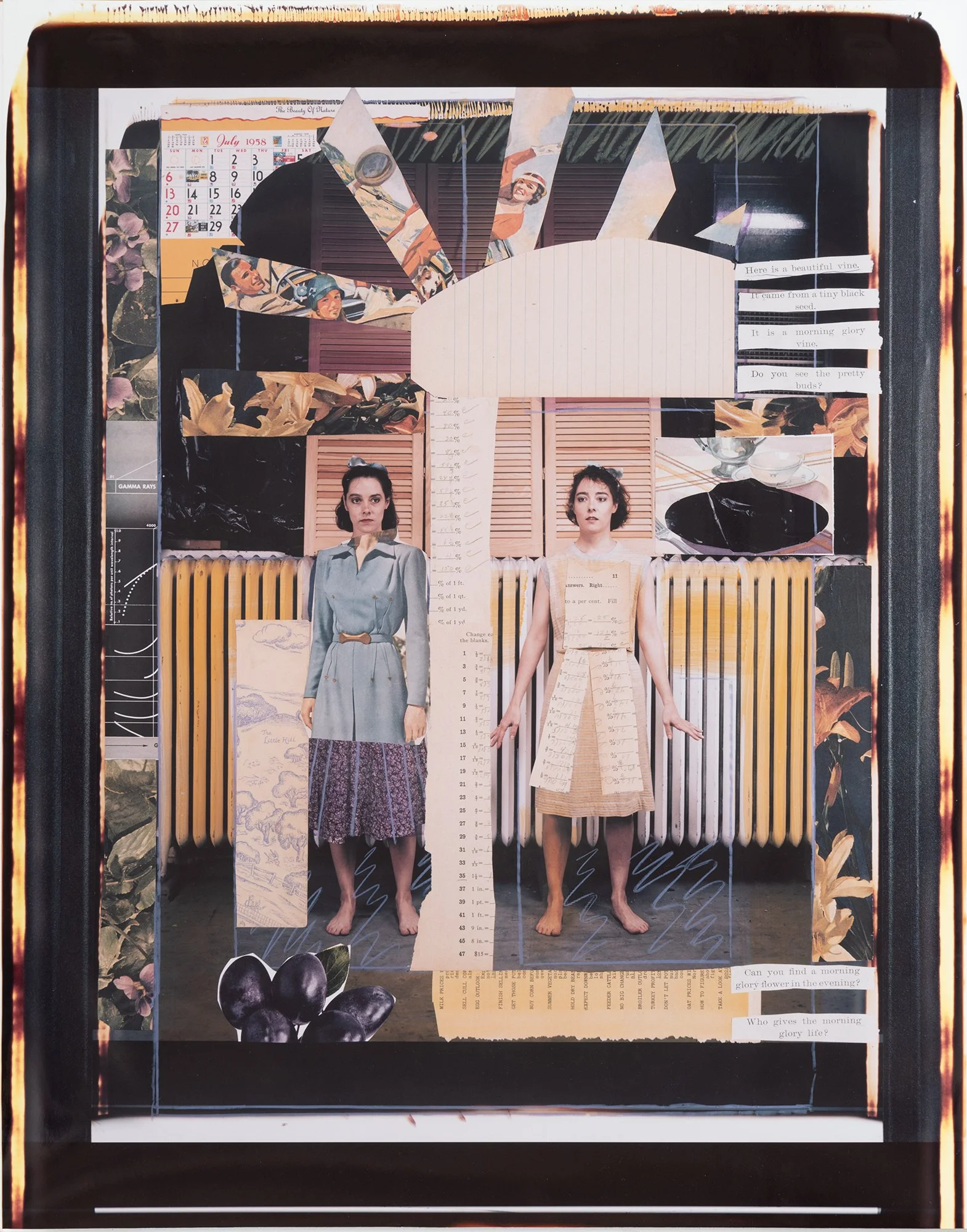By Jeffrey Whetstone, April 10, 2025
Colleen and Kathleen Kenyon were artists, organizers, and twins. They were born minutes apart in 1951 and passed away mere months apart in 2022 and 2023. Their posthumous retrospective exhibition at Center for Photography at Woodstock through May 4 charts the course of their artistic careers and their varied practices that revolve around second wave feminism, the expanded field of photography, and critique of mass media. But most of all, they orbited around each other and the communities they helped build. Together as artists, organizers, and administrators, Colleen and Kathleen Kenyon ran and greatly expanded the Center for Photography at Woodstock for more than twenty years.
The Kenyon sisters began their photographic education at the age of ten as clothing models working with professional photographers. In their teens, both were interested in and often employed by the fashion industry. This position gave each an early insight into how photography and capitalism merged to challenge the autonomy of women. By the time they were college age they were precociously political, devout feminists, and fluent in the new language of post-modern photography.
The Center for Photography at Woodstock (CPW) gathered about 45 artworks and ephemera from the Colleen and Kathleen Kenyon archive in a focused exhibition that navigates the viewer through the sisters’ inseparable artistic journeys. The work at the CPW ranges from the years 1979 to 1995 - years when photography was outgrowing its tiny and cloistered room in the basement of the art world. The art world the Kenyon sisters embraced and foreshadowed was in historic flux in the late seventies and early eighties, and the Kenyon sisters were attuned to theradical gestures emanating from Los Angeles and New York. But they didn’t need either dominant art city to thrive as artists. They had each other. They became their own unique community, spinning around each other and forging for themselves a new vocabulary of the medium that was self-reflexive and aware of the effects of the insidious politics of mass media image production.
Colleen and Kathleen’s lives and work were so intertwined it is difficult to separate them a quarter century later. Kathleen’s work primarily consists of applied collage made of clippings from print media and catalogs. The collages are directed at the methods by which the capitalistic enterprise enforces stereotypical roles on women to encourage and solidify their homebound consumer status. An image like one in the series “How We Learn, How We Grow (1979-1981)” features a man and woman as central elements, functioning as twin pillars in the composition. They resemble figures from an educational publication. The heteronormative nuclear family is conflated with the capitalist insistence on social class climbing. Around the figures are collaged words like “Tiffany,” and images of silver spoons that intimate how people learn hierarchical social structures and grow from cradle to grave through consumption aiming toward luxury. As a collage it pays homage to Barbara Kruger, Robert Rauschenberg, Hannah Hoch, and Max Ernst.
The main body of Colleen’s work in the exhibition is hand colored silver gelatin prints that feature portraits in raking, gridded light and sharp shadows. Man Ray, Manual Alvarez Bravo, and Imogen Cunningham come to mind. The work seems to come from a surrealist impulse as well as modernist photographers’ obsession with how light moves across the surfaces of the world. The color tint applied to the surfaces of the photographs augment that sharp edged aesthetic with playful fantasy.
The most fascinating and revealing work in the exhibition is when each sister’s work begins to collapse into the other, when their work becomes a visual call-and-response.
One image from Colleen Kenyon echoes the collage impulse form her sister, Kathleen. Both women are photographed behind a volleyball net; one of the sisters’ faces is partially obscured. The net applies a grid over the image, and Colleen’s coloring pigments painted over the surface of the photograph reinforces the geometric layering. Woven linen tape, a hidden structural material commonly used to bind books and display photographs, is adeptly applied on the surface of the image, right in the middle, dividing the picture into four quadrants. The impulse of constructing a picture with geometries inside the photographed scene as well applied to the surface of the print allude to Kathleen’s collage work. Colleen, so steeped in modernist photographic history and form is responding, in her own register, to Kathleen’s call.
Likewise, Kathleen’s series “Sacred Children (1979-1981)” is a response to Colleen’s work. These images are not applied collage, but instead, they use light from an intense flash to cut through figures with contrasting shadow lines. Kathleen further realizes a collaged aesthetic by cutting the paper backgrounding the portraits. She adds bits of clothing that misshape and fragment the photographed body. It’s a flat photographic print without any surface application, much like most of her sister’s work, yet fractured within the image. The pastel-colored chromogenic prints allude to Colleen’s applied oil pastels on her silver gelatin prints. Kathleen’s use of light, albeit strobe, is akin to Colleen’s predilection for sharp shadows that cut through surfaces.
Throughout the show, looking at oneself in a mirror transforms into looking at the other through a window. That not only applies to the content of the pictures, but how the images are constructed. Collage as a motif applies to how lives are put together, duplicated, often interchangeable, yet remain uniquely constructed. Kathleen and Colleen served as each other’s muse, and that relationship generated artwork about a feminist possibility of a new photography. It also fostered cultural work that developed new types of artistic communities that support women artists. That legacy is alive and well.
Jeffrey Whetstone is a photographer, writer, and educator. He received a Guggenheim Fellowship in 2008, and is the director of the Visual Arts Program at Princeton University.
COLLEEN KENYON "Colleen and KAthleen, Phoenicia, New York" 1978.
COLLEEN KENYON "Composition with Ball", 1990.
KATHLEEN KENYON "Plain Girl Husband on the Loose" 1984.
KATHLEEN KENYON "Setting the Clock on the VCR" 1994.
KATHLEEN KENYON "Untitled" 1995.






